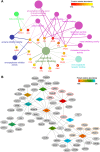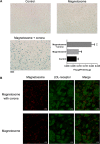A Protein Corona Adsorbed to a Bacterial Magnetosome Affects Its Cellular Uptake
- PMID: 32189964
- PMCID: PMC7065717
- DOI: 10.2147/IJN.S220082
A Protein Corona Adsorbed to a Bacterial Magnetosome Affects Its Cellular Uptake
Abstract
Purpose: It is well known that when exposed to human blood plasma, nanoparticles are predominantly coated by a layer of proteins, forming a corona that will mediate the subsequent cell interactions. Magnetosomes are protein-rich membrane nanoparticles which are synthesized by magnetic bacteria; these have gained a lot of attention owing to their unique magnetic and biochemical characteristics. Nevertheless, whether bacterial magnetosomes have a corona after interacting with the plasma, and how such a corona affects nanoparticle-cell interactions is yet to be elucidated. The aim of this study was to characterize corona formation around a bacterial magnetosome and to assess the functional consequences.
Methods: Magnetosomes were isolated from the magnetotactic bacteria, M. gryphiswaldense (MSR-1). Size, morphology, and zeta potential were measured by transmission electron microscopy and dynamic light scattering. A quantitative characterization of plasma corona proteins was performed using LC-MS/MS. Protein absorption was further examined by circular dichroism and the effect of the corona on cellular uptake was investigated by microscopy and spectroscopy.
Results: Various serum proteins were found to be selectively adsorbed on the surface of the bacterial magnetosomes following plasma exposure, forming a corona. Compared to the pristine magnetosomes, the acquired corona promoted efficient cellular uptake by human vascular endothelial cells. Using a protein-interaction prediction method, we identified cell surface receptors that could potentially associate with abundant corona components. Of these, one abundant corona protein, ApoE, may be responsible for internalization of the magnetosome-corona complex through LDL receptor-mediated internalization.
Conclusion: Our findings provide clues as to the physiological response to magnetosomes and also reveal the corona composition of this membrane-coated nanomaterial after exposure to blood plasma.
Keywords: LC-MS/MS; biogenic magnetic nanoparticle; cellular interaction; cellular uptake.
© 2020 Lai et al.
Conflict of interest statement
The authors report no conflicts of interest in this work.
Figures






Similar articles
-
Probing the Nanostructure and Arrangement of Bacterial Magnetosomes by Small-Angle X-Ray Scattering.Appl Environ Microbiol. 2019 Nov 27;85(24):e01513-19. doi: 10.1128/AEM.01513-19. Print 2019 Dec 15. Appl Environ Microbiol. 2019. PMID: 31604767 Free PMC article.
-
Effects of Environmental Conditions on High-Yield Magnetosome Production by Magnetospirillum gryphiswaldense MSR-1.Iran Biomed J. 2019 May;23(3):209-19. doi: 10.29252/.23.3.209. Epub 2019 Feb 24. Iran Biomed J. 2019. PMID: 30797225 Free PMC article.
-
Overproduction of Magnetosomes by Genomic Amplification of Biosynthesis-Related Gene Clusters in a Magnetotactic Bacterium.Appl Environ Microbiol. 2016 May 2;82(10):3032-3041. doi: 10.1128/AEM.03860-15. Print 2016 May 15. Appl Environ Microbiol. 2016. PMID: 26969709 Free PMC article.
-
The bacterial magnetosome: a unique prokaryotic organelle.J Mol Microbiol Biotechnol. 2013;23(1-2):63-80. doi: 10.1159/000346543. Epub 2013 Apr 18. J Mol Microbiol Biotechnol. 2013. PMID: 23615196 Review.
-
A Look into the Biochemistry of Magnetosome Biosynthesis in Magnetotactic Bacteria.ACS Chem Biol. 2017 Jan 20;12(1):13-22. doi: 10.1021/acschembio.6b01000. Epub 2016 Dec 16. ACS Chem Biol. 2017. PMID: 27930882 Review.
Cited by
-
Comparing the Colloidal Stabilities of Commercial and Biogenic Iron Oxide Nanoparticles That Have Potential In Vitro/In Vivo Applications.Molecules. 2023 Jun 21;28(13):4895. doi: 10.3390/molecules28134895. Molecules. 2023. PMID: 37446557 Free PMC article.
-
Strategy for Avoiding Protein Corona Inhibition of Targeted Drug Delivery by Linking Recombinant Affibody Scaffold to Magnetosomes.Int J Nanomedicine. 2022 Feb 11;17:665-680. doi: 10.2147/IJN.S338349. eCollection 2022. Int J Nanomedicine. 2022. PMID: 35185331 Free PMC article.
-
Large-Scale Cultivation of Magnetotactic Bacteria and the Optimism for Sustainable and Cheap Approaches in Nanotechnology.Mar Drugs. 2023 Jan 19;21(2):60. doi: 10.3390/md21020060. Mar Drugs. 2023. PMID: 36827100 Free PMC article. Review.
-
Bacterial Magnetosomes Release Iron Ions and Induce Regulation of Iron Homeostasis in Endothelial Cells.Nanomaterials (Basel). 2022 Nov 13;12(22):3995. doi: 10.3390/nano12223995. Nanomaterials (Basel). 2022. PMID: 36432281 Free PMC article.
-
Indian Herb-Derived Phytoconstituent-Based Antiviral, Antimicrobial and Antifungal Formulation: An Oral Rinse Candidate for Oral Hygiene and the Potential Prevention of COVID-19 Outbreaks.Pathogens. 2021 Sep 2;10(9):1130. doi: 10.3390/pathogens10091130. Pathogens. 2021. PMID: 34578161 Free PMC article.
References
-
- Ullrich S, Kube M, Schübbe S, Reinhardt R, Schüler D. A hypervariable 130-kilobase genomic region of Magnetospirillum gryphiswaldense comprises a magnetosome Island which undergoes frequent rearrangements during stationary growth. J Bacteriol. 2005;187(21):7176–7184. doi:10.1128/JB.187.21.7176-7184.2005 - DOI - PMC - PubMed
-
- Bazylinski DA, Lefèvre CT, Lower BH. Magnetotactic bacteria, magnetosomes, and nanotechnology In: Barton LL, Bazylinski DA, Xu H, editors. Nanomicrobiology: Physiological and Environmental Characteristics. New York (NY): Springer; 2014:39–74.
-
- Matsunaga T, Arakaki A. Molecular bioengineering of bacterial magnetic particles for biotechnological applications In: Schüler D, editor. Magnetoreception and Magnetosomes in Bacteria. Berlin, Heidelberg: Springer; 2007:227–254.
-
- Komeili A. Cell biology of magnetosome formation In: Schüler D, editor. Magnetoreception and Magnetosomes in Bacteria. Berlin, Heidelberg: Springer; 2007:163–174.
MeSH terms
Substances
LinkOut - more resources
Full Text Sources
Research Materials
Miscellaneous

